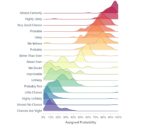
by tyler garrett | May 25, 2025 | Data Visual
In the contemporary world of analytics, making sense of continuous data variables can be overwhelming without the right approach. Continuous data variables can reveal hidden trends, unlock unprecedented competitive advantages, and maximize return on your investment in data analytics tools. However, only when these insights are effectively communicated through intelligent binning strategies can your organization unlock their full potential. Visual binning transforms complex numerical data into intuitive, easy-to-grasp visuals—enabling faster, smarter, and strategic business decision-making. In this article, we’ll explain powerful visual binning techniques and strategies, ensuring your analytics yield clarity, accuracy, and actionable insights that transform raw numbers into strategic advantage.
Understanding the Need for Visual Binning in Data Analysis
The overwhelming abundance of continuous numerical data holds immense potential, yet often remains untapped due to its inherent complexity. With numbers spanning infinite ranges, continuous data can become difficult to interpret without an effective method to simplify its granularity into understandable, actionable categories. This is precisely where visual binning emerges—offering strategists and stakeholders invaluable insights by segmenting continuous variables into bins, then visually presenting these bins to facilitate comprehension and decision-making. Rather than sifting through rows of complex numbers, stakeholders are armed with intuitive visual groupings that clearly portray trends, outliers, patterns, and anomalies.
Visual binning addresses common business scenarios in predictive analytics, including accurate demand prediction, profit forecasting, risk assessments, and marketing segmentation analysis. Effective binning enables organizations to unlock insights that improve forecasting accuracy, streamline data-driven decisions, and boost marketing efficacy.
For example, consider working with PostgreSQL databases under complex data handling scenarios; a skilled expert from our team specializing in PostgreSQL consulting services could efficiently build stored procedures or views to help visualize bins effectively at the database level itself, thus enhancing your analytics processes end-to-end.
Approaches to Visual Binning: Selecting the Right Methodology
Choosing the right visual binning strategy hinges upon clearly understanding the type, distribution, and specific business questions associated with your data. Common binning methodologies include Equal-width binning, Equal-frequency (quantile) binning, and Custom interval binning.
Equal-width Binning: Simplicity in Visualization
Equal-width binning divides continuous variables into segments with consistent interval widths. For example, ages between 10-20, 20-30, and so on. This popular method is straightforward to interpret and highly intuitive for visualization, making it ideal for deploying quick, actionable insights. If your analysis goal involves easily understandable breakdowns, particularly for broad decision guidance, equal-width binning provides simplicity and clarity.
However, simplicity may obscure subtle distribution irregularities or mask important outliers, leaving business-critical fluctuations hidden in a single bin. For organizations chasing deeper insights into subtle patterns—for example, when considering subtle operational optimizations like those discussed in predictive pipeline scaling based on historical workloads—Equal-width binning should be deployed carefully alongside additional analytical methods.
Equal-frequency (Quantile) Binning: Precise Insights Delivered
Quantile binning divides data into bins holding an even distribution of data points rather than consistent intervals. For instance, quartiles and percentiles use this approach. Equal-frequency bins adeptly highlight density differentiation—capturing subtle differences and outliers, thus popularizing it among advanced analytics applications. This approach works exceptionally well for businesses that must closely monitor distribution shifts, outliers, or intense competitive analytical scenarios where deeper insights directly create strategic advantage.
For situations like customer segmentation and profitability analyses, where understanding subtle trends at specific intervals is crucial, quantile binning provides superior granularity. Businesses adopting modern practices, such as those explored in our recent article on real-time data processing using Node.js, would significantly benefit from precise quantile binning.
Custom Interval Binning: Tailored for Your Organization’s Needs
In highly specialized contexts, standard methods won’t suffice. That’s where custom interval binning steps into play—empowering organizations to create personalized bins based upon domain-specific expertise, business logic, or industry standards. Often utilized in areas that require precise categorization, such as healthcare analytics, financial credit risk modeling, or customer segmentation related to highly specific metrics, custom binning provides unmatched flexibility and strategic insight.
Establishing custom bins entails significant domain expertise and data-driven rationale aligned with clear business objectives. By leveraging custom intervals, stakeholders align analytics close to business objectives such as gathering clear data for case studies—something we explore deeply in creating data-driven case studies that convert. Precision control and tailored visualizations are hallmark advantages of this approach, helping precisely inform complex decisions.
Visualization Best Practices: Transforming Insight into Action
No matter which binning methodology you adopt, effective visualization remains crucial. Making data accessible to decision-makers requires implementing tangible visual best practices. Clearly labeling bins, defining intervals transparently, and incorporating appropriate visual encoding techniques are essential.
Animated transitions in visualizations, as explored in our guide on animated transitions in interactive visualizations, further augment user experience. Animated transitions enable stakeholders to trace clearly through the story your data reveals—bridging the gap between analysis and business strategy effectively.
Interactive visualizations also enhance organizational understanding—allowing stakeholders to dive deeper into the data or dynamically adjust binning strategies. Dashboards that showcase visual binning paired with intuitive, interactive consumer controls effectively enable non-technical stakeholders, empowering them with real-time, actionable insights tailored specifically to their evolving business context.
Advanced Strategies: Enhancing Your Visual Binning Capabilities
Beyond standard visualization strategies, businesses should explore advanced methodologies including data security implementations, pipeline optimization, and leveraging AI-powered software tools.
For instance, integrating database-level row-level security as illustrated in our article on row-level security implementation in data transformation flows ensures secure visualizations and analytics—improving stakeholder trust.
In addition, optimizing your data pipeline using techniques such as those detailed in our guide on Bloom filter applications for pipeline optimization helps accelerate analytics and removes unnecessary latency from visualizations. Embracing AI also profoundly expands analytic capabilities, as outlined in 20 use cases where ChatGPT can help small businesses, a starter resource for organizations looking to innovate further in their strategic capabilities.
Being conscious about software and operational costs proves essential too; as highlighted in our insights into escalating SaaS costs, adopting flexible and cost-effective analytics tooling directly boosts continuous success.
Applying Visual Binning to Your Business
Proper implementation of visual binning strategies allows businesses to make smarter decisions, identify underlying risks and opportunities faster, and accelerate stakeholder understanding. Identifying the right methodology, integrating powerful visualization practices, adopting strategic security measures, and continuously evaluating operational optimization ensures your organization can confidently leverage continuous data variables for sustainable, strategic decision-making.
Are you ready to leverage visual binning strategies in your analytics process? Reach out today, and let our seasoned consultants strategize your analytics journey, unleashing the full potential of your business data.
Thank you for your support, follow DEV3LOPCOM, LLC on LinkedIn and YouTube.

by tyler garrett | May 24, 2025 | Data Visual
In an era where data fuels strategic decision-making, delivering timely, relevant, and accessible insights to stakeholders is critical. However, relevant analytics are only as good as their accessibility—and user experience matters deeply. With business leaders, executives, and team members accessing critical information via smartphones, tablets, laptops, or large monitor walls, responsive visualization design becomes a non-negotiable imperative. As data strategists and leading-edge software consultants, we’ve seen firsthand how responsive visual design dramatically improves analytics adoption and intuitive decision-making. Building dashboards and interactive analytical visualizations isn’t merely about aesthetics or functionality in silos—it’s about creating unified, cross-device experiences that seamlessly enable insight-driven action. This is the essence of enabling genuinely responsive analytics—designing visual interfaces that tell powerful stories clearly, succinctly, and consistently, regardless of the viewing device.
Understanding the Importance of Responsive Visualization
Organizations today operate in dynamic, fast-moving environments. Executives do not have the luxury of waiting until they’re in front of a desktop monitor to make critical decisions based on analytics—nor do frontline field workers always have the convenience of secure office networks to check essential operational data. Responsive visualization design inherently acknowledges this reality by constraining and molding data-driven insights into meaningful visual outputs that fit perfectly across all types of screens and devices, ensuring accessibility and clarity anywhere.
Our experience with the tech-driven construction industry exemplifies the demand for responsive dashboards. For instance, integrating analytics with platforms through Procore API consulting services proved valuable in enabling field workers on construction sites to swiftly consume analytics through mobile interfaces. Bringing real-time data visualizations to on-the-ground teams requires dashboards optimized for smartphones or tablets, empowering rapid, well-informed decisions without reliance on desktop setups.
Incorporating responsive designs greatly supports adoption by minimizing barriers to insight consumption. As emphasized in our blog post discussing creating executive dashboards for meaningful decisions, a key success factor includes dashboards that instantly adapt to different contexts, workflows, and roles. Responsive visualizations allow executives and employees to instantly understand complex data insights, whether they’re checking a quick report on their mobile phones or analyzing performance metrics at their office desks.
Principles and Best Practices for Responsive Data Visualization
Simplicity in Data Representation
One of the fundamental principles of responsive visualization design is simplicity. Mobile devices inherently have smaller screens, requiring visual elements that communicate clearly and swiftly. Overly complex visualizations may deliver remarkable details on large desktop monitors, but quickly lose readability and usability when viewed on a smartphone device. Therefore, prioritize minimalism and simplicity to ensure the essential information is instantly recognizable and actionable.
Strategically employing visual hierarchy—highlighting critical metrics clearly, placing crucial KPIs at the forefront, and limiting excessive metrics—facilitates quick comprehension. Utilizing best practices such as progressive disclosure, straightforward bar and line charts, and a conservative color palette ensures visualizations remain impactful, ensure clarity, and offer actionable insights, even in constrained spaces.
Adaptive Content and Modular Design
Adapting for mobile devices isn’t merely about shrinking visual elements—it’s about fundamentally re-thinking content from a modular standpoint. Responsive analytics visualizations should break complex dashboards into modular tiles that can reshape flexibly, permitting enhancing content adaptability to various devices and screen orientations. Layers of interaction and data hierarchy emerge intuitively as device size and real-estate increases from smartphone to desktop.
As we’ve outlined previously in our exploration of privacy-preserving analytics with synthetic data, flexibility in viewing data at varying levels of granularity supports both comprehension and secure data handling. Responsive visualization development should similarly allow stakeholders to easily toggle between simple overviews and detailed drill-down scenarios without cognitive overload on smaller screens.
Responsive Visualization Technologies and Tools
Modern visualization tools and platforms now integrate responsiveness inherently, enabling designers and developers to create responsive dashboards efficiently. Solutions such as Tableau, Power BI, and D3.js have robust features facilitating adaptive visualizations without extensive additional coding. Beyond dashboards, building robust APIs and modern data pipelines further ensures analytical data continuously feeds responsive visualizations with accurate and up-to-date information.
Moreover, leveraging responsive visual analytics that integrate with real-time data streaming delivers significant value for rapid business decisions. As discussed in our post highlighting the importance of data streaming in fraud prevention and detection, the fusion of real-time streamed data with responsive visual interface design broadens accessibility to critical insights, eliminating latency in decision making across all devices.
Additionally, advanced monitoring solutions tailored to pipeline drift detection benefit greatly from responsive capabilities, ensuring analytics remain promptly actionable regardless of location or device. Implementing responsive visualization through innovative tooling ensures critical insights get properly presented to decision-makers wherever needed.
Overcoming Responsive Design Challenges
One inherent challenge to responsive visualization and analytics delivery is managing performance while preserving data fidelity across various devices. Smaller devices typically have less processing power, demanding optimized code and streamlined data payloads. Applying best practices like caching, intelligent data sampling, and efficient rendering significantly enhances responsive analytical performance without comprising insight accuracy.
Another critical challenge involves designing information architectures flexible enough for multiple screens while rigorous enough to convey powerful insights without confusion. As noted in our exploration of using causal inference frameworks in business decision support, structured and carefully organized information architectures contribute significantly to robust and insightful analytical experiences. Correctly applying responsive layout grids, dynamic resizing constraints, and employing iterative user testing sessions ensures analytics visuals retain meaning and efficient interaction patterns regardless of the individual end-user’s device.
We also encourage decision-makers and technical strategists adopting responsive designs to proactively learn from user feedback loops. Collaborative sessions conducted in ways similar to our post about 1-on-1 expertise sessions to improve tool adoption offer invaluable insights into user behaviors and unexpected pain points, streamlining iteration and significantly boosting visualization adoption across multiple devices.
Using Responsive Analytics to Impactful Industry-Specific Outcomes
Responsive visualization design becomes particularly impactful in addressing specific industry needs. For instance, cities currently adopting responsive analytics as part of digitally enabled sustainability strategies leverage visualization across multiple connected device categories—from public informational kiosks to smartphone reporting apps and sophisticated command centers. Our collaboration and exploration of improving Austin’s urban sustainability through analytics showcases vividly how responsive data visualization optimizes public policy implementation and community engagement significantly.
Similarly, the healthcare industry strongly benefits from responsive visualizations that accurately and clearly communicate real-time patient monitoring information and health data inputs across medical practitioners’ handheld and desktop devices. The capacity to review data fluidly from wearable devices, tablets, and desktop applications drastically improves responsiveness to medical crises or patient care adjustments.
The critical factor across these varied industries remains straightforward—increase stakeholder access and lower complexity to maximize analytics’ value proposition. Responsive visualization, when executed correctly, becomes a competitive differentiator and a facilitator for innovative analytical breakthroughs across digital transformation journeys.
Conclusion: Building Adaptable, Powerful Analytics Experiences
Responsive visualization design isn’t merely a supplementary feature to modern analytics—it’s a conversation-starting requirement. Effective analytics today demands intelligent responsiveness as stakeholders universally shift toward mobile and multi-device engagements. Organizations harnessing this responsiveness ensure deeper analytic adoption, clearer communication, improved knowledge retention, and ultimately, stronger and more informed decision-making.
At Dev3lop, our expert strategists offer not only technical expertise but also strategic roadmap support for transitioning analytics environments to wholly responsive platforms. Our commitment centers around effectively bridging the gap between data insight and real-world decision-making by enhancing data visualization accessibility, intuitiveness, and actionable outcomes across any device stakeholders leverage.
Through thoughtful, responsive analytics design, your stakeholders effectively engage and intelligently utilize data, laying the foundation for the next tier of digital innovation success.
Thank you for your support, follow DEV3LOPCOM, LLC on LinkedIn and YouTube.

by tyler garrett | May 24, 2025 | Data Visual
In an era where decision-making requires swift insights derived from complex data, effective visualization becomes critical. Small multiples, fundamentally an information visualization technique, deliver exceptional comparative analytical capability by breaking down intricate datasets into digestible visual segments. These small, repeated visuals arranged side by side can transform overwhelming data structures into intuitive understanding. As decision-makers and analysts grapple with the ever-increasing volume of data, small multiples offer clarity, efficiency, and precision. Today, we explore the strategic application of small multiples in comparative analysis—helping you harness data-driven insights to precision-tune your organization’s strategic vision and connect technical excellence with impactful business outcomes.
Understanding Small Multiples: What and Why?
Small multiples are simplistic yet powerful visualization techniques—utilizing repeated, uniform charts placed side by side for direct visual comparison. Rather than merging multiple data sets or cramming information into a single, unwieldy chart, each “multiple” encapsulates a singular subset of the data, facilitating swift and insightful comparison across groups. This method eliminates visual clutter and significantly increases interpretability, aiding organizational leaders and technical stakeholders alike in making informed, data-driven decisions rapidly.
In an era heavily driven by big data, visualization mechanisms can quickly become cluttered or overwhelming. Small multiples confront this challenge head-on, streamlining complex relational insights into concise, comparative grids. When compared accurately through standardized axes and scale, decision-makers leverage intuitive analytical storytelling that highlights trends and outliers clearly. Furthermore, effective comparative analysis positions your organization to proactively adjust strategies—feeding directly into advanced services such as mastering demand forecasting with predictive analytics, thus enabling optimized and efficient supply-chain operations driven by insightful visualization.
Choosing the appropriate visualization is akin to selecting the right technology stack or database platform. For teams utilizing databases like PostgreSQL, aligning the power of visualization with your database infrastructure becomes seamless through strategic alignment with trusted partners specializing in PostgreSQL consulting services.
Implementing Small Multiples Effectively in Your Organization
Selecting the Appropriate Data
A successful small multiples implementation starts with thoughtfully selecting data appropriate for comparative purposes. When embarking on comparative visualizations, prioritizing data consistency, format integrity, and clean data cleanliness are vital. Often, challenges in data quality can impede accurate interpretation, underscoring the role of robust data engineering and stable data infrastructures. Stay ahead of the curve by learning about emerging trends and how advanced data engineering trends in 2025 can boost profitability.
Furthermore, the underlying databases supplying data must support consistent and accurate comparisons. This directly influences stakeholder comprehension, ensuring accurate interpretations and, consequently, sound decision-making. Organizations should factor systematic schema practices, leveraging industry-standard schema evolution patterns with backward, forward compatibility, ensuring database agility and consistent accuracy within comparative visualizations like small multiples.
Choosing Metrics & Visual Encoding
Effective small multiples visualizations hinge on selecting meaningful metrics paired with appropriate visual encoding methods—whether color-coding, size differentiation, or shapes and forms. Technical stakeholders and decision-makers alike must prioritize clarity over complexity, employing restrained visual design choices that align visual encoding with logical data representation.
Understanding visualization foundations facilitates accuracy and meaningful synthesis; newcomers can revisit foundational principles by reviewing tutorials such as creating a basic bar chart or line graph in your preferred data visualization tool. Thoughtful selection fosters clear visual messaging enhancing both technical and strategic understanding across your organization.
Scalability and Automation of Small Multiples
Implementing automation facilitates scalable, accurate, and timely small multiples visualization solutions—a critical benefit in our speed-oriented business ecosystems. Automated visualization pipelines can depend on various workflow patterns, prompting strategic discussions around pipeline execution planning and static versus dynamic approaches. Leveraging automated frameworks ensures accurate, repeatable representations empowering decision-makers with confidence in their conclusions.
Automation aligns data governance processes effectively, safeguarding data quality, systemizing effective security, and reinforcing your analytics and reporting confidence. Integrating automation and ETL processes can enhance small multiples accuracy, as noted in various practical scenarios detailed in our blog post, 10 examples where ETL is playing a key role in data governance and security, underscoring data visualization’s integral connection to high-quality, governed datasets.
Advanced Analytics and Innovation Through Small Multiples
Leveraging Advanced Analytical Models
Organizations driving growth and profitability through innovation recognize visualization as a foundational element for advanced analytics. When visualization embraces innovative practices such as small multiples, organizations facilitate advanced analyses—including predictive analytics, trend forecasting, and comparative analyses. Small multiples combined with analytical forecasting pave the way for more sophisticated decision-making scenarios.
Executing sophisticated predictive analytics and demand forecasting requires streamlined, reliable, and robust visual communication tools. By integrating predictive analytical demand-forecasting methodologies alongside visually intuitive technologies like small multiples, enterprises significantly enhance strategic decision-making abilities—bringing tangible, actionable business outcomes to fruition.
Pushing Beyond the Boundaries
Small multiples implementation can act as a stepping stone toward revolutionary developments in technological exploration, prompting innovative strategic directions, such as exploring emerging trends and paradigm shifts. Exploring futuristic domains such as quantum computing or leveraging forward-thinking employment of Python ecosystems, like those detailed in our article on exploring four important Python libraries for enhanced development in 2023, becomes achievable with clear visualization and comparison capabilities.
By harnessing small multiples to succinctly communicate complex analytical results, organizations can focus greater resources toward innovative and visionary strategic initiatives—reinforcing their commitment to continuously advancing technological prowess.
Avoiding Common Pitfalls in Using Small Multiples
Effective small multiples implementation mitigates common visualization missteps such as inconsistent formats, incompatible scales, and cluttered confusion—which often lead stakeholders to ignore or gloss over your insights. For organizations experiencing low readership of impactful visualizations and reports, understanding repercussions beyond the technical implementation is essential. Our article, “No One Looks at Your Reports – Ouch”, provides valuable recommendations on addressing this critical gap, combining technical and strategic approaches effectively.
Furthermore, systematic standardization involving defined table structures and schema architecture, as discussed in our in-depth guide “Create Table: Defining a New Table Structure in SQL”, guarantees consistency across visualizations. Precise consistency leads directly to better user interpretations and enhanced comparative analysis that strengthens organizational agility, clarity, and confidence.
Conclusion: Driving Strategic Decisions Through Effective Visualization
Implementing small multiples equips organizations with the visualization power to elevate comparative analysis potential substantially. By employing thoughtfully designed, selectively automated, and strategically implemented small multiples, contemporary decision-makers transcend mere data collection—enabling insightful, actionable analytical intelligence.
Effective implementation facilitates quicker, more accurate strategic understanding, providing transformative impacts across internal and external stakeholders. Employing advanced visual analytics drives innovation and profitability. Thus, integrating small multiples into your analytics strategy confidently pushes analytical and organizational boundaries for enduring competitive advantages, allowing you to shape the organization’s technological trajectory effectively.
Thank you for your support, follow DEV3LOPCOM, LLC on LinkedIn and YouTube.

by tyler garrett | May 24, 2025 | Data Visual
In today’s era of big data and analytics-driven decisions, the capacity to clearly and effectively communicate insights becomes essential. Data visualization, at its core, is not just about charts and graphs—it is about visual storytelling. Selecting an effective color palette is crucial; one incorrect color choice could make pivotal insights in your data inaccessible or misleading. While data might seem purely analytical, the science behind visualization is deeply artistic, especially when it comes to colors and their psychological implications. Implementing a proper color theory, especially color harmony, elevates data clarity, improves user understanding, and enhances decision-making accuracy. Whether you’re analyzing historical sales data, exploring multifaceted information collateral, or engaging audiences with efficient dashboards, understanding color harmony will set your visualizations apart, amplify insight communication, and drive meaningful business actions.
Understanding Color Harmony: Beyond Aesthetic Appeal
Color harmony involves a deliberate, thoughtful selection and combination of colors to create visual balance and coherence. It’s more than simply finding complementary colors; it’s understanding the psychological and cognitive impact colors have on your audience. In data visualization contexts, color harmony enhances readability and clarity, guiding the viewer naturally through data stories without unnecessary cognitive strain. Commonly used color harmony models in visual communications include analogous, monochromatic, complementary, and triadic schemes, each with distinctive impacts. Analogous colors, situated close to each other on the color wheel, create a smooth and harmonious look, ideal for categorically related data groups. Complementary schemes, involving opposite colors, enhance contrast, greatly benefiting comparative visualizations, like company performance year-over-year or the performance of regional markets. For quantitative data visualizations, monochromatic schemes utilize variations of a single color—effectively showing data intensity or magnitudes clearly without distraction.
Applying these principles requires awareness of the underlying data structure as well. Understanding your data—diversified and multifaceted by design—is key to appropriately translating data categories, hierarchical structures, or numeric scales into colors that resonate effectively. Representational clarity achieved through thoughtfully calibrated color palettes significantly reduces cognitive load, leading decision-makers toward faster, more accurate conclusions.
The Psychological and Cultural Context of Color Choices
The consideration of viewer psychology and cultural meanings behind colors is critical in data storytelling. For instance, in many Western contexts, red often signals urgency or negative values, while green embodies positivity, growth, or profitability—a distinction that proves foundational in visual representations of business’s wins and risks. However, this isn’t universally applicable, making context-awareness paramount when visualizing global data. Particularly in analyses like industry-led growth in data analytics, visualizations incorporating culturally-sensitive, clearly-defined color contexts create narratives that resonate universally and avoid misleading decision-makers.
Moreover, psychological perception factors into color palette choice. The human brain naturally associates certain colors with feelings and concepts. For example, blue hues communicate trust and stability, often appearing prominently in corporate visualizations to instill credibility. By leveraging these intrinsic psychological connotations, strategic visual design choices aid in clearly communicating complex details to stakeholders while also ensuring alignment with your company’s branding and messaging direction.
Effective visual communication, according to color harmony principles, therefore involves extensive consideration of audience perception and culturally-bound interpretations. Clear, conscious choices ensure visualizations don’t unintentionally misguide the viewer—an essential consideration when building dashboards or high-level strategic reports crucial for impactful business decisions.
Implementing Color Harmony in Data Warehousing and Visualization Projects
Bespoke data warehousing solutions and data visualizations involve vast volumes of complex data, such as those described in approaches toward data warehousing consulting services. Dealing with scalability, context-awareness, and analytics-ready architecture demands emphasis on optimized visual delivery as well. Color harmony in data visualizations within warehouses isn’t about aesthetics alone—it’s strategic biometric science. How efficiently can users discern patterns, anomalies, or opportunities via the data visualization? Color harmony matches analytic rigor with perceptual ease.
In enterprise-grade analytics solutions, data visualizations—powered by multiple internal datasets such as sales performance, production metrics, or even datasets employing temporal tables to track historical information—can be quickly made cumbersome by poor color choices. Implementing harmonious color schemes helps manage viewer attention strategically, enabling users to effortlessly identify deviations, recognize trends, and explore insights. Effective and harmonious coloration selection thus reduces visual noise and enhances user understanding, facilitating quick navigation through granular and complex scenarios—increasing usability and ensuring efficient insights.
Therefore, executing analytics-driven data initiatives should include deliberate strategizing around color-choice consistency to maintain navigability, clarity, and long-term sustainability as data volume and diversity naturally scale upward.
Pitfalls to Avoid: Common Issues When Choosing Colors for Data Visualizations
While clearly outlined benefits make color harmony increasingly attractive, it’s equally vital to understand potential pitfalls when integrating these theories into your visual outputs. Overwhelming users with excessive color variations causes visual clutter. Inappropriate color encodings for critical categorizations—for instance, representing key values with excessively similar hues—erodes interpretability. Strategic professionals recommend purposeful minimalism: limiting palettes to fewer clearly distinguishable colors, which provides visual comfort for longer explorations, as detailed in this guide on avoiding clutter and unnecessary decorations in visualizations.
Another common oversight is color vision deficiency—a critical area of accessibility in data visualization. Blues and yellows offer better color distinction for broader audiences, whereas reds and greens may hide valuable insights from affected decision-makers. Failing to verify accessibility results in partial audience alienation—countering your core visualization objectives.
Above all, avoid attaching subjective aesthetics to data sector colors without logical justifications. Every chosen hue should carry explanatory logic aligned to visualization intent, supporting your credibility and amplifying clarity. Following best practices protect dashboards from unintentionally bottlenecking decision-making clarity due to naïve or arbitrary aesthetic-driven palettes.
Innovative Approaches and Future Considerations
Innovations such as automated color palette selection leveraging environmental and context-driven insights—like those proposed in context-aware data processing frameworks—present exciting applications for future data visualization strategy. Quality analytical visuals increasingly incorporate dynamic palettes that respond swiftly to specific analytical contexts. This innovation promotes insightful storytelling, making advanced data pipelines not only context-aware but also visually responsive in real-time.
Additionally, color harmony can align seamlessly with broader initiatives like adopting content-addressable storage (CAS) for data warehousing—a storage concept explored thoroughly in this article about content-addressable storage in immutable data warehousing. Harmonious visuals amplify the effectiveness of immutable datasets, especially those retained for transparency or compliance needs.
Adaptation to evolving digital landscapes like multi-tenant cloud architectures, detailed expertly in this analysis of multi-tenant resource allocation, requires visualizations staying relevant and intuitive amidst the substantial complexities these datasets pose. Leaders and data strategists should remain adaptable about continuously exploring advancements capable of complementing sophisticated—and increasingly automated—data deployments.
Conclusion: Strategic Color Choices Drive Better Decisions
Strategic application of color harmony theory significantly elevates data visualization effectiveness. Thoughtfully applied color schemes not only enhance visual clarity but also streamline cognitive processing, enabling quicker, smarter decisions. Leveraging color harmony principles helps avoid common visualization pitfalls, incorporates psychological and cultural insights, and moves beyond aesthetics—driving actionable insights in today’s fast-paced analytics environments.
In every visualization endeavor, remember: your organization’s resource data strength mirrors not only analytical rigor but visual competence as well. Embracing strategic color harmony provides clearer vision—leading directly toward informed decision-making and tangible organizational success.
Thank you for your support, follow DEV3LOPCOM, LLC on LinkedIn and YouTube.

by tyler garrett | May 23, 2025 | Data Visual
In today’s rapidly evolving data-driven environment, clarity in data representation is crucial for informed decision-making. As complexity grows, traditional two-dimensional charts often fall short, especially when dealing with compositional datasets. Three-variable compositional data—where the sum is typically constant, like percentages summing up to 100%—presents unique visualization challenges. Enter ternary plots, a powerful visualization technique specifically tailored to unravel such complex three-dimensional compositions within a simple, insightful triangular representation. As data-driven strategy leaders at the cutting-edge of innovation and analytics, we continually strive to help organizations unlock deep insights from their data. Let’s delve into the significance, methods, and strategic applications of ternary plots and explore how utilizing sophisticated data visualization methods can propel your business decisions by turning complexity into simplicity.
Understanding Ternary Plots: The Triangle of Insight
At its core, a ternary plot is a triangular, graphical representation designed explicitly for compositional data with three interdependent variables. Traditionally, compositional data struggles with standard visualization methods because the components are not independent—they’re constrained by their collective sum. This is typical in chemical compositions, market share analysis, budgeting components, and many other fields where data points collectively sum to a fixed value.
A ternary plot cleverly addresses this challenge. It visualizes each composition within an equilateral triangle, with each vertex representing a 100% contribution from a single component. The sides of the triangle then measure the composition’s proportions, enabling a clear visualization of complex interrelationships. For instance, it’s immediately evident if one component dominates or if there’s a balanced mix between the three variables.
This format allows for a uniquely effective insight layer, empowering decision-makers to quickly grasp nuanced relationships. Imagine a scenario involving budget allocations: traditional bar charts may obscure the balanced interplay between R&D, marketing, and operational expenses. Ternary visualizations, instead, enable stakeholders to grasp at a glance how smoothly each domain harmonizes within the total budget allocation—an advantage that resonates across industries from finance to advanced data governance practices.
The Methodology Behind Ternary Plots: Simplifying Complexity
Constructing ternary plots begins by normalization of compositional data into percentages, ensuring the total adds precisely to unity (or 100%). This normalization ensures consistency and comparability across data points within a dataset, effectively standardizing the compositional structure for clear interpretation. Once normalized, these three-dimensional proportions are represented as points within the triangular coordinate system.
Interpreting ternary plots becomes intuitive rapidly. Points closest to a vertex indicate dominant values of the respective component, while points near the center depict balanced or equal contributions from each component. A trajectory line or clustered data points within the triangle can clearly highlight trends, distributions, or even outlier anomalies—providing crucial insights underlying your data landscapes.
Incorporating advanced analytics solutions through visualization techniques like ternary plots often complements broader analytic frameworks. For strategic enhancements of your organization’s analytics maturity, integrating advanced data visualizations works synergistically with services such as Power BI consulting or interactive dashboard implementations like interactive Tableau dashboards. Leveraging these specialized approaches helps stakeholders tap into dynamic insights easily understandable across diverse technical proficiencies—accelerating informed decision-making.
Real-World Applications of Ternary Visualization
Ternary plots find utility widely in multiple industries, effortlessly displaying compositional relationships within complex datasets. For instance, geochemists routinely leverage ternary diagrams to interpret chemical compositions of rocks and minerals, quickly identifying geological origins or generation processes. Similarly, market analysts employ them effectively for visualizing market share relationships between three competing products or sectors, offering distinct visual clarity compared to conventional bar charts.
This visualization’s versatility stretches beyond chemistry and economics—ternary plots have extensive relevance in fields such as environmental sciences, industrial manufacturing compositions optimization, nutritional compositions, or financial asset allocations. In nutritional sciences, a ternary visual effortlessly highlights proportions of macronutrients (proteins, carbohydrates, fats), aiding diet strategists to formulate balanced meal regimens.
Further, applying ternary approaches to fundamental business challenges offers unparalleled strategic clarity, such as quickly identifying unbalanced resource allocations signaling the necessity for deeper investments in data warehousing solutions or revealing imbalances that traditional analyses typically miss.
Enhancing Decision-Making Capabilities with Ternary Plots
In today’s world, real-time data exploration, understanding business intelligence tool capabilities, and effective data governance strategies are fundamental elements of enterprise success. Ternary plots significantly enrich decision-makers’ analytical capabilities by translating sophisticated data relationships into visual constructs readily understood by diverse stakeholder groups.
Enterprise analytics environments benefit significantly from adopting visualizations like ternary plots integrated into query mesh optimizations for performance and advanced approximate query processing. Analytics practitioners gain comprehensive perspectives when presented visually rather than through numeric complexity, increasing overall transparency in communicating findings. This enhanced interpretability ensures decision-makers can quickly grasp crucial insights and respond with accuracy to strategic requirements.
Organizations progressively shifting focus to analytical maturity often find illustrative visualization techniques instrumental in communicating actionable insights clearly. As businesses consider adopting advanced analytical strategies, integrating rigorous visualization methodologies strongly complements implementations such as privacy-preserving homomorphic encryption analytics or advanced ETL frameworks analyzed in our comprehensive ETL implementation case studies. Visual clarity further reinforces compliance, governance, and strategic alignment, significantly amplifying overall analytic maturity.
Choosing Visualization Tools: Open Source or Commercial?
Selecting the right visualization solution determines success in effectively interpreting complex compositional datasets. Organizations face a critical choice between robust commercial solutions and the flexibility and innovation of open-source visualization tools. Each holds particular strengths suited uniquely to different enterprise scenarios.
Commercial visualization software like Tableau or Microsoft Power BI offers well-integrated, highly polished solutions, complete with customer support, structured product cycles, and user-friendly interfaces ideal for enterprise-level environments. On the other hand, open-source visualization software such as matplotlib, Plotly, or ggtern (derived from R’s ggplot2) offers exceptional flexibility and extensive customizable features ideal for data-savvy organizations craving advanced tool customizations.
Understanding the subtle yet crucial differences between these options can significantly streamline deployment and enhance business insights effectively. To delve deeper, we recommend exploring our detailed industry comparison guide: Comparison of open-source and commercial ETL solutions, helping you strategically align visualization solutions with your organizational demands.
Final Thoughts: Embracing Ternary Plots for Strategic Clarity
Incorporating ternary plots into your data visualization toolbox reaffirms your organization’s strategic emphasis on visualization-assisted decision-making. Decision-makers empowered by intuitive visualization techniques gain indispensable clarity, crucial in driving strategic decisions across various compositional data contexts.
By leveraging ternary visualization methods, your organization gains a significant advantage in interpreting compositional interactions intuitively and accurately. These methods amplify the effectiveness of your analytical strategy, enabling quick recognition of trends, outliers, and underlying relationships hidden within intricate datasets. In other words, effective data visualization methods—as explored in-depth within our discussion on the importance of data visualization in data science—play an instrumental role in transforming complexity into streamlined strategic insights.
As leaders and consultants specializing in analytics strategy and data innovation, we strongly recommend incorporating ternary plots into analytics workflows to improve clarity, communication, and strategic alignment. Begin appreciating the invaluable power that strategic visualization brings—simplifying, clarifying, and decisively enhancing organizational strategy in today’s rapidly evolving data ecosystem.
Thank you for your support, follow DEV3LOPCOM, LLC on LinkedIn and YouTube.

by tyler garrett | May 23, 2025 | Data Visual
In today’s world of lightning-fast decisions and complex analytics, executives and technical leaders alike are demanding data visualization tools that deliver immediate insights without the added weight of sluggish performance. However, even the best analytical software can stumble if its canvas is poorly optimized. At a strategic level, a canvas not optimized properly can negatively influence data-based decision-making, slowing down productivity and obscuring critical insights. Whether you’re looking to enhance user engagement, gain quicker insights, or prevent inefficient analytical processes from holding your organization back, optimizing your data visualization canvas should be a top priority. Let’s dive into essential strategies for canvas optimization that will empower your high-performance analytics and position your business for innovation and data-driven victories.
The Importance of Canvas Optimization in Today’s Visualization Environment
The exponential growth in data volumes demands a clear strategic shift toward performance-oriented visualization practices. Without effective canvas optimization, visualizations that were once enjoyable and interactive become slow to load, less responsive, and detrimental to effective decision-making workflows. Optimizing a canvas isn’t merely a technical exercise—it’s a step forward in enhancing your analytical efficiency and delivering value to end-users.
Proper optimization reduces latency, enhances user engagement and clarity, and allows your organization to maintain a data-centric competitive advantage. For instance, slow-loading dashboards rapidly frustrate users and diminish trust in data-driven initiatives. Just as ineffective tools can halt your progression—highlighted well in our recent article titled The Most Overrated Tools in Modern Data Engineering—poor canvas performance can become a bottleneck for strategic initiatives. Conversely, optimized canvases streamline efficiency and help focus users’ attention and analytical efforts, ensuring data storytelling remains concise and compelling.
At its core, canvas optimization enhances human-data interaction by ensuring visualizations load quickly, refresh effortlessly, and accurately convey complex analytics at a high-performance level. Prioritizing optimization positions your organization to leverage analytics fully, streamlining decision-making processes and establishing a foundation upon which future innovation can confidently build.
Understanding Canvas Bottlenecks: The First Step Towards Effective Optimization
Identifying bottlenecks within visualization canvases is foundational to achieving effective optimization. A canvas bottleneck is anything that hinders the visualization or interaction speed, degrading the user experience. Common bottleneck examples include inefficient rendering processes, extensive and unnecessary data requests, poor caching practices, overly complex calculations, and redundant layers of visualization.
One primary culprit is often excessive data loading and insufficiently optimized APIs. Implementing robust backend APIs designed for efficiency—like those built through our expert Node.js consulting services—helps minimize the loading latency experienced on the client visualization side. Of course, data itself must also be carefully managed: datasets too large or unfiltered during initial load times can drastically reduce performance. Addressing this requires careful database query practices, including understanding proper database operations such as Union and Union All operations in SQL, to ensure queries remain quick and effective.
Another prevalent canvas bottleneck is unoptimized code execution in visualization libraries. Complex dashboards built without performance considerations often have multiple visual refreshes triggered simultaneously, making visual interactions sluggish as the system struggles with unnecessary renderings. Incorporating diagnostics and thoughtful architectural design allows enterprises to recognize and rectify these inefficiencies immediately.
Strategies to Optimize Your Data Visualization Canvas
Prioritize User-Centric Design and Simplification
An effective visualization canvas shouldn’t overwhelm decision-makers; it should simplify complexity. Thus, an optimized canvas starts with user-centric designs built specifically around user intent and ultimate readability. Avoid overly complex visualizations that may look impressive but sacrifice clarity and performance. Instead, invest in clearly communicating insights without unnecessary embellishments. Conducting user feedback loops and analytics working sessions—as emphasized in our article that explains how working sessions reduce miscommunication in analytics projects—can significantly help in maintaining user-oriented canvases.
Adopt Efficient Data Handling and API Management
Efficient canvas performance significantly depends on how you manage incoming data streams and API requests. Ensure your APIs are performance-oriented, ensure efficient database designs, and make thoughtful decisions about caching, filtering, and querying data. Utilize dynamic queries and employ intelligent data management techniques to fetch and load just the data you need—no more, no less. By paying close attention to best-practice database query techniques and upholding data volume control, your visualization canvas will experience significantly increased responsiveness and immediate rendering capabilities.
Control Canvas Interactivity and Redraw Frequency
Highly interactive dashboards can deliver unparalleled user experiences. However, excessive interactivity without boundaries can inadvertently introduce performance degradation. Carefully considering interactivity and investing in thoughtful control helps you strike the right balance between providing value to users without jeopardizing canvas performance. Limit visualization redraw frequencies by batching user interactions or establishing buffering strategies. This tactic actively prevents excessive canvas repaint and helps maintain a snappy, impressive visualization environment.
Overcoming Data Silos and Privacy Barriers for Improved Canvas Architecture
Optimizing your visualization canvas involves more than just visual and technical design—organization-wide data access is critical. If your visualizations are struggling, it’s likely data silos, security regulations, or poorly structured data pipelines are partially to blame. The detrimental impact of these aspects is well-explained in our analytics article on how to spot data silos holding your business back. Breaking down these silos and ensuring consistently reliable data access should become integral parts of your broader canvas optimization strategy.
Additionally, the ever-growing emphasis on data privacy can introduce further complexity. Regulations such as GDPR and CCPA, explained thoroughly in our article on Data privacy regulations and their impact on analytics, directly affect how visualizations interact with data. Smart canvas optimization adheres to privacy standards and incorporates security standards proactively, ensuring stakeholders can access accurate data immediately while preserving underlying user privacy protections.
Killing the Underperforming Dashboard Before It Kills Your Strategy
Sometimes, optimization requires tough calls. Inefficient dashboards can consume time, resources, and energy unnecessarily, ultimately leading to misguided strategy and frustration among stakeholders. As candidly discussed in our strategic article How to Kill a Dashboard Before It Kills Your Strategy, letting go of legacy dashboards that no longer effectively serve user needs can significantly enhance the effectiveness of your visualization landscape.
While it may seem counterintuitive, phasing out poorly optimized canvases and dashboards timely provides the opportunity to refocus attention and resources on genuinely high-performance data visualizations. Adopt a mindset of continuous evaluation and iterative improvement, ensuring your investment in data visualization infrastructure continually advances your organization’s strategic goals rather than hindering them.
Building Sustainable Visualization Infrastructure through Optimization
High-performance visualization isn’t a one-off project; it’s a continuous cycle of improvements. Maintain open dialogues among decision-makers, business units, and technical leaders to ensure alignment between optimization efforts and strategic objectives. Routine diagnostic testing, use of reliable monitoring tools, and continuous collaboration across your entire analytics ecosystem will ensure your canvas architecture remains consistently effective.
Ultimately, canvas optimization directly affects your organization’s overall analytics maturity and actionability of insights provided. It’s essential to orient your infrastructure toward efficiency, user-centric interactions, and responsiveness. By following these recommendations, your organization will enhance its capacity to make informed, dynamic decisions with quick turnaround times, thereby unleashing further innovation and growth potential throughout its analytics programs.
Thank you for your support, follow DEV3LOPCOM, LLC on LinkedIn and YouTube.
























